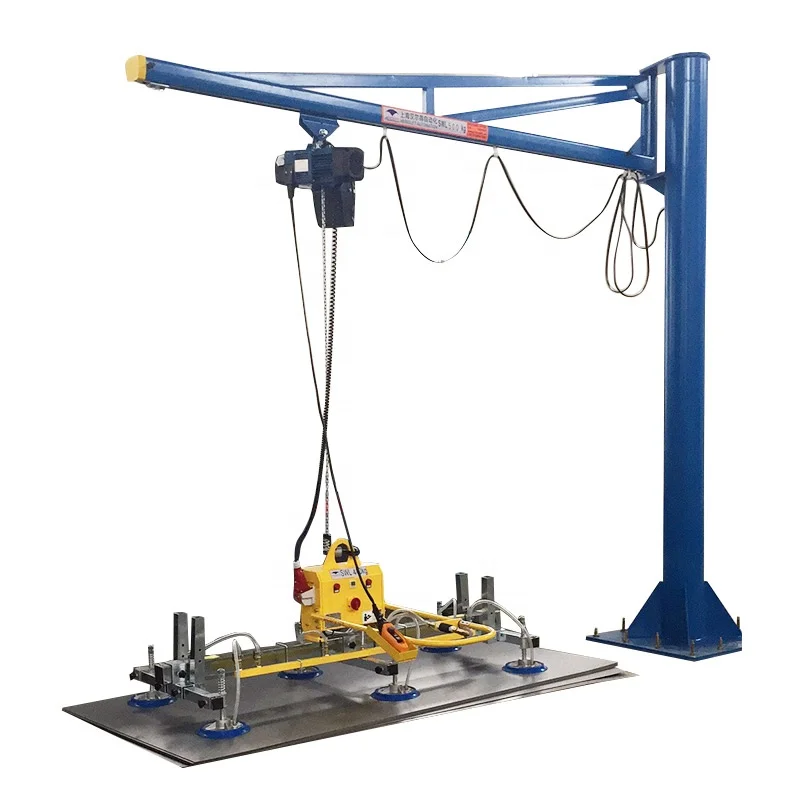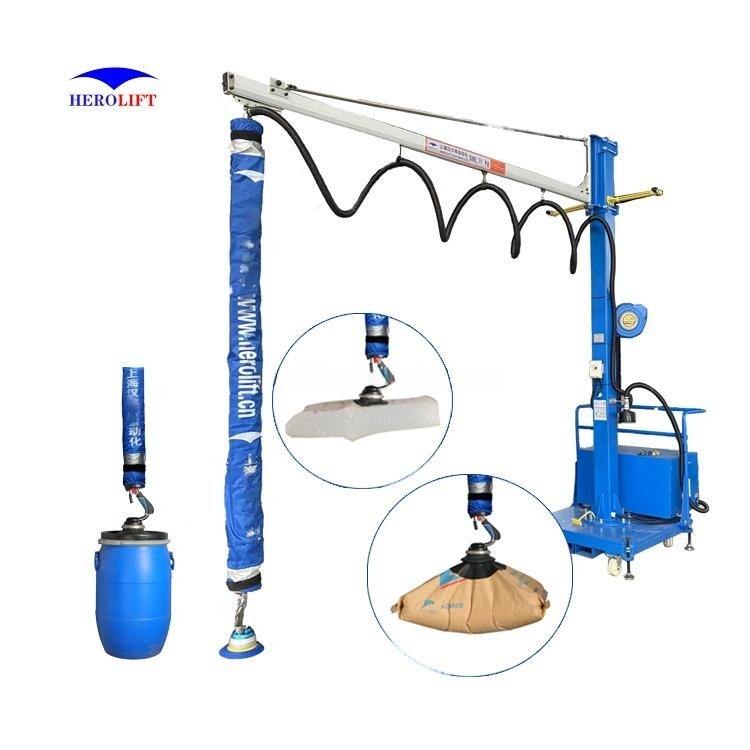Detaljna analiza pneumatic vakuumskih liftova i klapi: komparativna studija sa hidrauličkim liftovima

U oblastima rukovanja materijalima i vertikalne transportacije, pneumaticki sistemi su privukli značajan interes zbog svoje efikasnosti i prilagodljivosti. Ovaj članak se fokusira na rad, primene i uporedbu dva ključna komponenta u ovom domenu— pneumaticki vakuum liftovi i klizeta—za dobijanje kompletnog uvida u njihove mogućnosti performansi.
Uvod u pneumaticke vakuum liftove
Pneumaticki vakuumski lift je uređaj koji koristi pritisak zraka da podigne i prenese teške predmete. Radi stvaranjem vakuuma koji se lepi na površinu tereta, omogućavajući sigurno i efikasno manipulisanje. Ovi liftovi su posebno korisni u industrijama gde su materijali osetljivi ili nepravilno oblični, kao što su staklo, listovački metal i ambalnažni materijali.
Lift se sastoji od vakuumskog štapa, pneumatickog vakuumskog ventila i upravljačkog sistema. Vakuumski štap formira zaključak protiv predmeta, dok pneumaticki vakuumski ventil reguliše protok zraka kako bi održao vakuum. Ovaj sistem omogućava operatorima da podignu i prenesu predmete sa minimalnim fizičkim naporem, smanjujući rizik od ozbiljenja i poboljšavajući produktivnost.
Uvod u pneumaticke vakuum liftove
Pneumaticki vakuumski lift je uređaj koji koristi pritisak zraka da podigne i prenese teške predmete. Radi stvaranjem vakuuma koji se lepi na površinu tereta, omogućavajući sigurno i efikasno manipulisanje. Ovi liftovi su posebno korisni u industrijama gde su materijali osetljivi ili nepravilno oblični, kao što su staklo, listovački metal i ambalnažni materijali.
Lift se sastoji od vakuumskog štapa, pneumatickog vakuumskog ventila i upravljačkog sistema. Vakuumski štap formira zaključak protiv predmeta, dok pneumaticki vakuumski ventil reguliše protok zraka kako bi održao vakuum. Ovaj sistem omogućava operatorima da podignu i prenesu predmete sa minimalnim fizičkim naporem, smanjujući rizik od ozbiljenja i poboljšavajući produktivnost.

Kako funkcionisu pneumaticki vakuumski ventili
Pneumaticki vakuumski klup je kljucan deo pneumatickog vakuumskog dizala. Upravlja tokom vazduha u i iz vakuumskog sistema, osiguravajuci da se vakuum odrzava dok je dizalo u funkciji. Klup obicno funkcioniše sa jednostavnim mehanizmom koji se otvara i zatvara na osnovu pritiska razlike koju stvara vakuum.
Kada se dizalo aktivira, klup se otvori, ispuštajući vazduh iz vakuumskog ploca kako bi se stvorio negativni pritisak koji sigurno drzi predmete. Nakon sto se predmet podigne, klup se moze prilagoditi da odrzi vakuum ili ga otpusti kada je potrebno smanjiti teret. Ova precizna kontrola je od vitalnog znacaja za osiguravanje bezbednosti i efikasnosti procesa dizanja.
Komparativna analiza pneumatickih vakuumskih dizala i hidraulickih dizala
Pneumatic vacuum lifts su namenjeni manipulaciji materijala, dok hidraulički liftovi imaju drugačiju funkciju: vertikalno prevoz ljudi i tereta unutar zgrade. Razumevanje razlika između ova dva sistema može da pojasni njihove odgovarajuće primene i prednosti.
1. Mecanism rada:
o Pneumatic Vacuum Lifts: Ovi uređaji ovisi o vazdušnom pritisku i vakuum tehnologiji za podizanje objekata. Vakuum se stvara uklanjanjem vazduha iz zaključane zone, što omogućava liftu da se priključi na teret.
o Hydraulic Lifts: S druge strane, hidraulički lift koristi hidrauličko ulje za podizanje šipke unutar cilindra. Kada se tekućina pumpira u cilindar, ona podiže kabine lifta. Ovaj sistem je opšte gledano moćniji i može da obradi teže terete na veće distance.
2. Brzina i efikasnost:
o Pneumaticki sistemi: Pneumatic vakuum liftovi su opšte gledano brži u obradi tereta jer mogu brzo pridruživati i otpinjati objekte. Ova brzina je korisna u okruženjima gde je vreme ključno, kao što su proizvodnja i skladištenje.
o Хидраулички системи: Hidraulički liftovi mogu imati sporeije brzine ubrzavanja i usporavanja, ali pružaju jednoliko radenje i mogu prevoziti veće optoke efikasnije na duže rastojanje.
3. Zahtevi po prostoru:
o Pneumatic Lifts: Ovi sistemi su opšte gledano kompaktniji i mogu se koristiti u uskim prostorima, čime postaju idealni za fabrike i radionice gde je prostor na premiumu.
o Hidraulički liftovi: Hidraulički sistemi zahtevaju više prostora za instalaciju hidrauličkih cilindara i povezanih komponenti, što može da ograniči njihovu upotrebu u manjim zgradama.
4. Održavanje i cena:
o Pneumaticki sistemi: Pneumatic vakuum liftovi obično imaju nižu cenu održavanja zbog manje kretljivih delova i bez potrebe za hidrauličkom ulja. Međutim, mogli bi tražiti periodične inspekcije kako bi se osiguralo da je vakuum zaključak nekvaran.
o Хидраулички системи: Hidraulički liftovi mogu biti skuplji za održavanje zbog složenosti hidrauličkog sistema i mogućnosti tekivanja tekućine. Međutim, ako su pravilno održavani, poznati su po svojoj trajnosti i dugovremenosti.
5. Primene:
o Pneumatic Vacuum Lifts: Ovi se široko koriste u proizvodnji, ambalaži i logističkim područjima gdje je ključno brzo i sigurno upravljanje materijalima.
o Hidraulički liftovi: Hidraulički liftovi se često mogu pronaći u poslovnim i stanovnim zgradama i idealni su za prevoz ljudi i teških predmeta između spratova.
Закључак
Pneumaticke vakuum liftovi i ventilaci igraju ključnu ulogu u savremenom upravljanju materijalima, pružajući efikasna i sigurna rešenja za dizanje i prevoz različitih tereta. Iako dijelomično deluju slično hidrauličkim liftovima, njihovi načini rada, brzine, potrebe po prostoru i primene su dosta različiti. Razumevanje ovih razlika može pomoći poduzećima da izaberu sistem koji odgovara njihovim specifičnim potrebama, što na kraju čini njihove operacije produktivnijim i sigurnijim. Kako se industrijalni sektor nastavlja da evoluiruje, potreba za efikasnim rešenjima za dizanje, kao što su pneumaticki vakuum liftovi, vjerovatno će rasti, čime postaju važan deo sveta upravljanja materijalima.

 EN
EN
 AR
AR
 HR
HR
 DA
DA
 NL
NL
 FR
FR
 DE
DE
 EL
EL
 IT
IT
 JA
JA
 KO
KO
 NO
NO
 PL
PL
 PT
PT
 RO
RO
 RU
RU
 ES
ES
 SV
SV
 TL
TL
 ID
ID
 LV
LV
 LT
LT
 SR
SR
 SL
SL
 UK
UK
 VI
VI
 HU
HU
 TH
TH
 TR
TR
 AF
AF
 MS
MS
 GA
GA
 BE
BE
 MK
MK
 AZ
AZ
 UR
UR
 EO
EO
 LA
LA
 MN
MN
 KK
KK





















